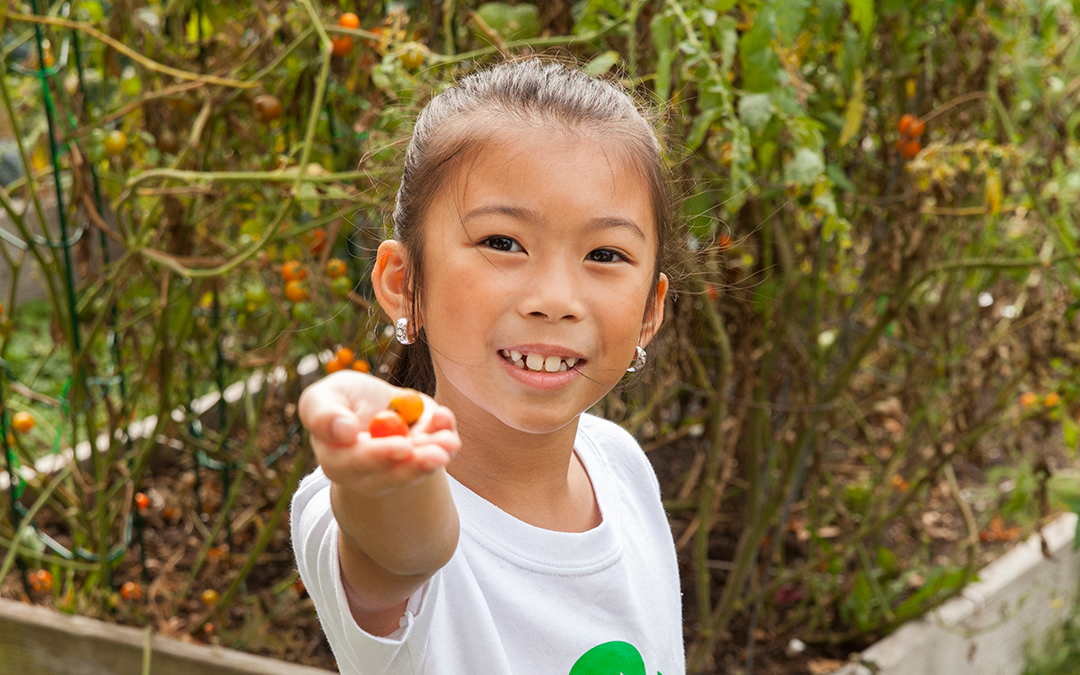Gardening is great for your mind, body and spirit. It’s a hobby that can keep you active, get you outdoors for fresh air and Vitamin D, mindfully reduce stress, and allow you to nurture something, which in turn can nurture you. Whether you have a large backyard with room for garden beds, or an apartment with sunny windowsills you and your troop can try your hand at growing plants. Garden projects are engaging for all ages, and while it might take some trial and error, the journey can help you learn more about the natural world and help you connect more with yourself and your Girl Scout. From starting from seed to building a DIY fairy garden, these gardening ideas will give your girls (and you) a Girl Scout green thumb in no time.
Save it for later!
Plant from seeds
Nurturing a plant through its entire life cycle can take longer than simply buying a plant that is already established, but it’s surprisingly fun and fulfilling to grow plants from seeds. It’s also the most inexpensive way to start, making it a great candidate for a community service Take Action project! Girls can start by picking out their seeds of choice from your local garden supply store or grocery store. To give their sprouts the best chance at success, be sure to look at the back of the seed packet to ensure that it the appropriate season to grow that plant, and that it will be happy in your climate zone.
Next, find a planter. A regular pot is a great choice, but an empty egg carton works well as a planter for beginning gardeners. Fill each section with a couple spoonfuls of soil and gently tuck in two to three seeds per section. Most seed packets tell you how long your plant will take to sprout, or how long it will take before it will be ready for harvest. Keep the soil moist, place in an area with good sunlight, and give those tiny sprouts words of encouragement as they grow into beautiful plants!
Pro Tip: Consider finding out what flowers and plants are native to your area, or important to your local ecosystem and plant those! That way your sprouts will grow not only into something beautiful, but a garden that supports local biodiversity.
Compost using worms
By making vermicompost, or worm compost, your girls can help reduce the amount of trash you are sending to the landfill and create nutrient rich soil for your girls to use in any future gardening project. Plus, it’s an awesome way for Girl Scouts to learn about some of the best decomposers—worms! Here’s what you’ll need:
- A plastic storage bin that you can fit in a dark place, like under the kitchen sink
- A drill
- Bedding for the worms- shredded newspaper works well
- Red wriggler worms
To start, girls will need to drill holes in their compost bins for air flow and drainage with the help of an adult Drill a constellation of ¼” holes every two inches on the sides and top of the bin. Next they’ll need to prep the worms’ new home for their arrival. On the bottom of the bin lay a layer a few inches deep of damp shredded paper. Then add some soil— discarded potting soil from a potted plant works great. Finally one last layer of shredded paper should do the trick.
Next you’ll need to add your red wriggler worms. Red wrigglers are the popular choice for composting because they live in the top six inches of the soil. You can order these online, or you might be able to find them at your local garden supply store. Add them to their home, and give them a few days to adjust. Once the girls can see that they are starting to decompose the contents of the bin, then start adding food scraps to the compost. Worms love foods like fruits and veggies, egg shells and coffee grounds. Things to avoid include citrus (too acidic), meat, and dairy. Its best to cut up the food scraps before adding them to the bin to help the worms break it down.
Keep the moisture level balanced in the vermicompost by adding more shredded paper, or another similar material every time you add scraps to the bin. Worms like a moist environment, but if there is too much standing water in the vermicompost they run the risk of drowning. The ideal moisture level is that of a wrung out sponge. Store the bin in a dark place with a comfortable temperature, such as under the kitchen sink. (And make sure parents are ok with this project in their house beforehand!
Worms only need a few things to thrive; air, water, bedding, and food. Monitor the moisture levels and contents of your worm bin, give the worms a few weeks to work their magic, and soon your girls will have rich, nutritious recycled soil ready to be used for any garden DIY ideas.
Create a succulent arrangement
Succulents are plants that are drought resistant because of their ability to store water in their leaves. This makes them easy to care for, and they come in an endless array of beautiful colors and shapes. To start, each girl will need several succulents and a planter large enough to hold them all. They can start by planning out their design! Your Girl Scouts might enjoy planting them in rainbow order, or they might choose monochromatic succulents but make their arrangement more interesting by mixing in plants with different shapes and textures. Once they are ready to plant, remove the succulents from their original containers and place them in the large planter according to their design, filling in the empty spaces with potting soil. Succulents love lots of sunlight and require less water than most other plants, making them some of the simplest plants to grow in your garden.
Pro Tip: If your girls find that they enjoy taking care of succulents, they can grow more without buying a whole new plant by propagating them! Simply take a leaf or a cutting from a succulent and place it in damp soil, and it will grow roots, turning into a new plant! This is a great way to share your plants with other members of your troop, so you can mix and match for an future succulent arrangements.
Paint a pot
Girl Scouts can bring some extra color and fun to their gardening project by decorating a pot! Create art that is beautiful and functional by using a pot as your medium. This is also a great way to add personality to upcycled items that you would like to use as planters, like old jars or cups. Choose a durable, water proof paint such as acrylic that will last for years to come. Younger girls can create thumbprint art, and older Girl Scouts might enjoy creating more detailed art, like mandalas. Once their masterpiece is completed, let it dry, and they can plant their favorite plant inside!
Pro-Tip: Our partner Jo-Ann sells different flower-pot decoration kits which are a perfect all-in-one project for any Girl Scout!
Fairy garden
Building fairy gardens is a great way to engage your girls to get outdoors and stretch their imaginations. Fairy gardens can be big or small, and be self-contained within a potted plant, or sprawling along the base of a backyard tree. Twigs and leaves make excellent fences and houses, and stones are great for pathways. Add battery operated fairy lights in a jar for ambiance at night, and have your Girl Scout bring along their favorite stuffed animal or figurine to make the fairy house a home!
Getting your Girl Scouts into gardening is an amazing way to boost their mood, get them curious about science and nature, and build their confidence as they watch their creations grow from sprouts into beautiful flowers and plants, maybe even getting to eat the literal fruits of their labor! It’s also an amazing way to give back to your community, whether through planting a community garden, or just having produce to share with their neighbors down the road. So what are you and your troop waiting for? Get gardening Girl Scout!
What to do next
- Find gardening tools and plants for your budding gardener, whether from Lowes or your local nursery.
- Here are more gardening ideas for your Girl Scout to try at home.
- In addition to gardening, try taking your Girl Scout out for a hike! See if she can identify any of the plants along the way.
- Exploring the great outdoors is a classic part of the Girl Scout experience. Learn about more GSNorCal outdoor programs or read other blog posts about girls soaking up nature.

Rebecca DuPont—Rebecca is a GSNorCal volunteer who started as a Girl Scout herself before getting a degree in Parks and Recreation and working in Environmental Education. She enjoys all things outdoors from biking, hiking, and birding, to staying home to water her patio garden and talking to her houseplants.

